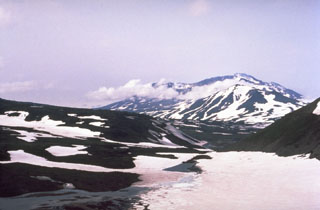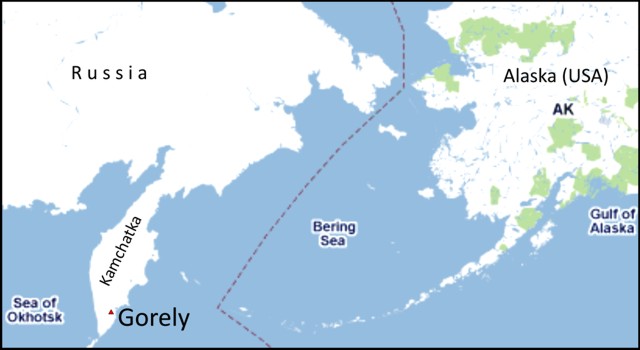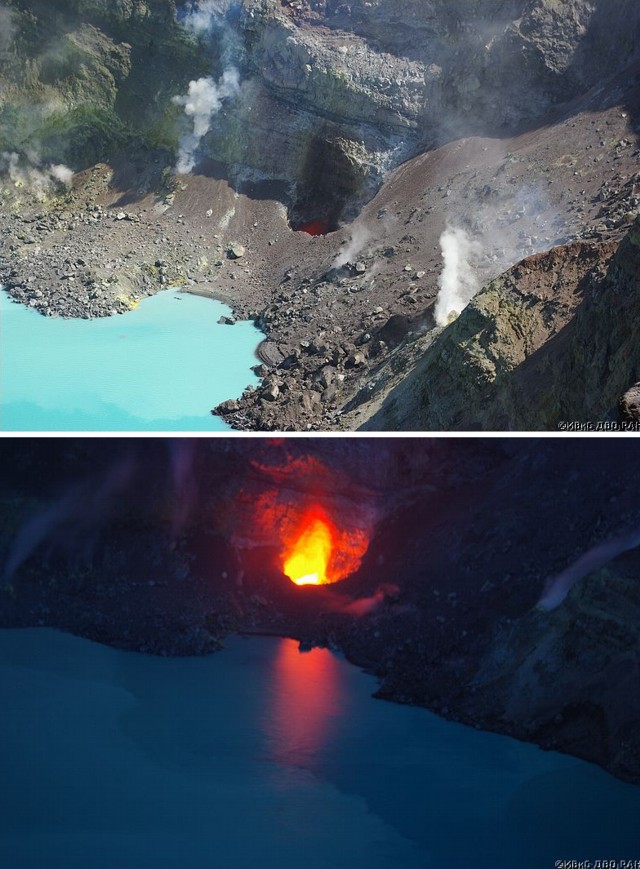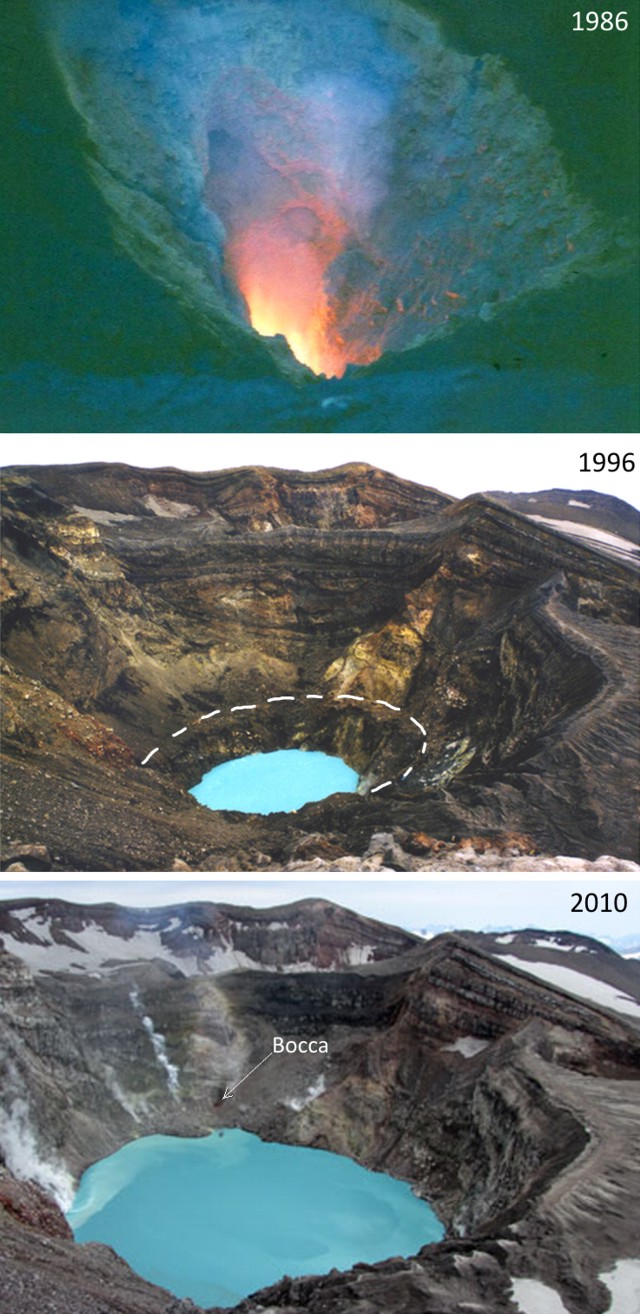Report on Gorely (Russia) — July 2010
Bulletin of the Global Volcanism Network, vol. 35, no. 7 (July 2010)
Managing Editor: Richard Wunderman.
Gorely (Russia) Minor June 2010 explosions and new, glowing vent in crater wall
Please cite this report as:
Global Volcanism Program, 2010. Report on Gorely (Russia) (Wunderman, R., ed.). Bulletin of the Global Volcanism Network, 35:7. Smithsonian Institution. https://doi.org/10.5479/si.GVP.BGVN201007-300070
Gorely
Russia
52.5549°N, 158.0358°E; summit elev. 1799 m
All times are local (unless otherwise noted)
Our last report about Gorely volcano in southern Kamchata (figure 1) described low seismicity in September 2000 (BGVN 25:09). The volcano generated at least seven eruptions in the 20th century, with the latest in August 1984. Below are available summaries of Gorely's activity from October 2000 to June 2010. The information came from various Russian sources credited below. During the first interval, between October 2000 and late October 2002, the volcano was generally quiet and mildly steaming with its lake occasionally boiling.
Activity during 23-29 October 2002. According to the Laboratory of Active Volcanism Institute of Volcanology and Seismology, IV&S, steam rose 300 m above Gorely's crater. During 2-3 October, about 30 earthquakes M ~ 1.2-1.7 were recorded, and on 26 October there were two M~ 1.7 earthquakes (information from Kamchatka Branch of the Geophysical Service of the Russian Academy of Sciences, KB GS RAS). There is only one seismic station ("Gorely") in the area of both Gorely and Mutnovsky, so it is difficult to determine the source of the seismicity and attribute the tremor to a specific volcano.
Activity during 2007-2009. On 25 December, the Kamchatka Volcanic Eruption Response Team (KVERT) reported an increase in seismicity and undisclosed visual observations of activity. Seismicity had increased on 22 December and remained slightly elevated above background levels during 22-25 December. On 25 December, a gas-steam plume rose to an altitude of 2.2 km.
KVERT reported on 11 January 2008 that seismic activity in the area of Gorely and Mutnovsky had been slightly elevated above background levels during the previous three weeks. On 13 June 2008 seismicity increased further. Moderate fumarolic activity was observed on 17 June. During 15-18 June, seismic activity near Gorely and Mutnovsky decreased. Seismic activity from Gorely increased again during 10-27 March 2009.
Activity during June 2010. Volcanic tremor began to increase slightly on 6 June and strong steam-and-gas emissions were noted. Scientists reported a small plume that rose 400-500 m above the crater and areas of recently deposited ash on the S flank. Tremor increased gradually during the next few days. By 12 June, tremor had risen to several times background values (figure 2). During 12-13 June strong steam-and-gas activity was again noted. On 12 June a substantial steam plume was visible from Petropavlosk-Kamchatsky, ~ 80 km away.
On 13 June, volcanologists observed continuous steaming to a height of ~ 300 m (Ovsyannikov and Chirkov, 2010). On 14 June, the plume rose about 1 km above the volcano (figure 3).
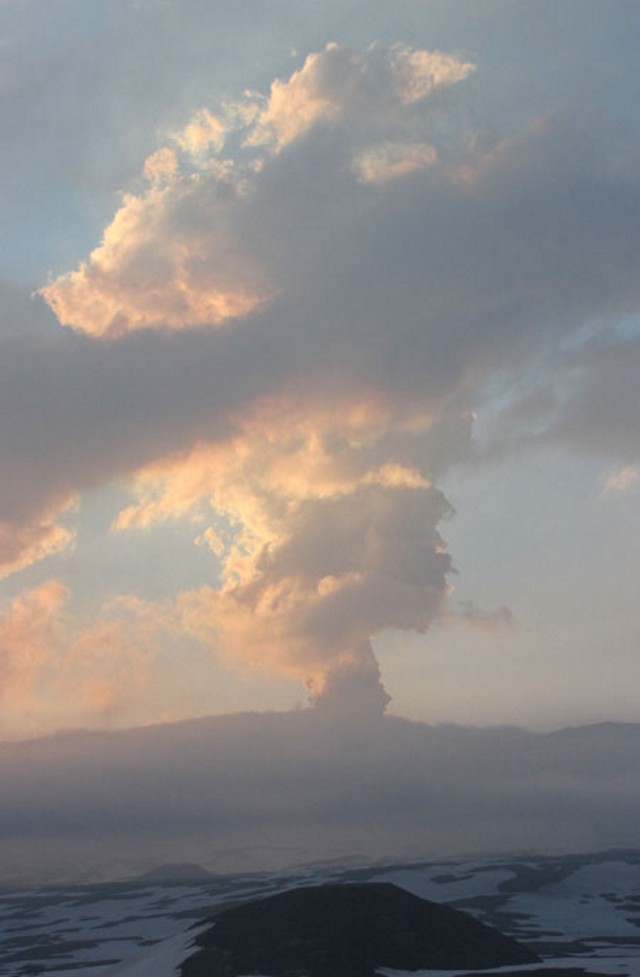 |
Figure 3. Unusual gas-steam emission from Gorely seen at a distance on 19 June 2010. Photo by Sergei Chirkov. |
Observers watching the volcano from 15 to 22 June reported that a new bocca vent, about 20 m in diameter, had formed at the base of the NE wall of the active crater containing a thermal acid lake. The vent's lowest edge was only 5-7 m above the lake level. As the vent formed, chunks of rock and colluvial deposits fell into the growing cavity. The hot gas ejected under high pressure from the vent was seen as a flaming, glowing crimson color (figure 4) and was accompanied by a constant, low rumble. The gas temperature at the outlet, measured by an infrared instrument, was 870°C.
Seismic activity remained above background levels during 24 June-2 July, with a further increase on 28-29 June. A gas-and-steam plume drifted 35 km S on 28 June.
The formation of gas-and-steam clouds is dependent on atmospheric conditions; at some times a white column was visible above the vent. However, sometimes the column was gray due to ash (figure 5, right). The ash was interpreted as exclusively non-juvenile material resulting from the collapse of wall rock into the vent.
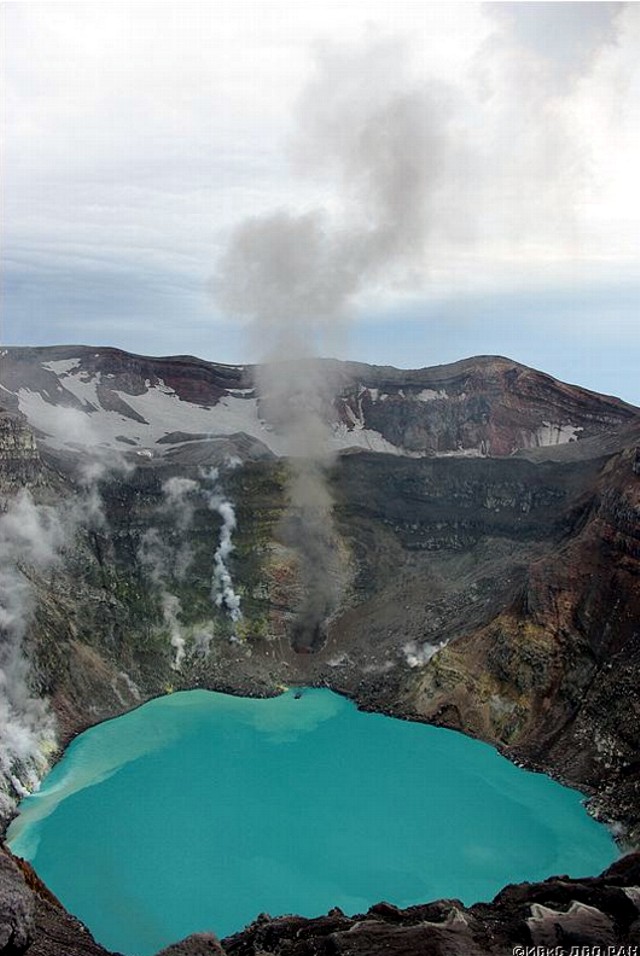 |
Figure 5. Ash-bearing clouds emerging from the new vent at Gorely on 19 June 2010. Photo by Sergei Chirkov. |
Activity during July 2010. According to KVERT, seismic activity remained above background levels during 9-23 July 2010, and gas-and-steam emissions rose from the crater most days. On 10 July, data suggested that the vent on the crater's inner NE wall, above the level of the lake, had grown to 2-3 times the original size. The lake level had also fallen. Gas-and-steam plumes drifted 25-150 km SE, E, and S during 10 and 14-15 July. Many new fumarolic vents were observed in the active crater. The temperature of a daily thermal anomaly detected over the volcano in satellite imagery gradually increased from 29 to 46°C during 17-21 July.
KVERT reported that during 23-30 July seismic activity from Gorely remained above background levels and volcanic tremor continued to be detected. On 26-27 July, gas-and-steam activity was noted.
Formation of the vent had no visible impact on the acid thermal lake. However, in some unconsolidated lake-shore sediments, the scientists observed small terraces (figure 4). This indicates successive intermittent lowering of the lake surface. These shifts may be related to the increased seismicity under the volcano.
Background. Observers saw a vent at the then-dry crater bottom during 1986 (figure 6, top). A vent on the NE crater's side was photographed in 1996; and can be compared with the latest vent observations (figure 6).
During 2000 through 3 August 2010, the only thermal anomalies detected in MODIS/MODVOLC satellite imagery occurred during June-August 2010 (16 June, 21 June, 11 July, 20 July, 27 July, and 3 August).
References. Gavrilenko, G., Melnikov, D., Ovsyannikov, A., 2008, Current state the thermal Lake into active crater Gorely (Kamchatka): Materials of Russian Scientific Conference "100 years of the Kamchatka expedition of the Russian Geographical Society 1908-1910." (Petropavlovsk-Kamchatsky, 22-27 Sept. 2008) (In Russian), Petropavlovsk-Kamchatsky, 2009, 267 p.
Leonov, V., 2006, Influence of depth breakthrough zone on the structure of volcano (the case of Gorely, Kamchatka): Volcanism and Geodynamics. Proceedings of III All-Russia Symposium on Volcanology and paleovolcanology, 5-8 September 2006, Ulan-Ude, 2006, p. 461-467.
Melekestsev, I.V., Braitseva, O.A., Ponomareva, V.V., 1987, Holocene activity dynamics of Mutnovskii and Gorelyi volcanoes and the volcanic risk for adjacent areas (as indicated by tephrochronological studies): Volc Seism, 1987, vol. 3, p. 3-18 (English translation 1990, vol. 9, p. 337-362).
Ovsyannikov, A. and Chirkov S., 2010, Activity (status) of Gorely volcano, June 2010: Bulletin of Kamchatka Regional Association (Educational-Scientific Center); Earth Sciences (in Russian), IV&S FEB RAS, Petropavlovsk-Kamchatsky, 2010, vol. 1, no. 15, ISSN 1816-5532 (Online).
Geological Summary. Gorely volcano consists of five small overlapping stratovolcanoes constructed along a WNW-ESE line within a large 9 x 13 km caldera. The caldera formed about 38,000-40,000 years ago accompanied by the eruption of about 100 km3 of tephra. The massive complex includes about 40 cinder cones, some of which contain acid or freshwater crater lakes; three major rift zones cut the complex. Another Holocene stratovolcano is located on the SW flank. Activity during the Holocene was characterized by frequent mild-to-moderate explosive eruptions along with a half dozen episodes of major lava extrusion. Early Holocene explosive activity, along with lava flows filled in much of the caldera. Quiescent periods became longer between 6,000 and 2,000 years ago, after which the activity was mainly explosive. About 600-650 years ago intermittent strong explosions and lava flow effusion accompanied frequent eruptions. Historical eruptions have consisted of moderate Vulcanian and phreatic explosions.
Information Contacts: Kamchatka Volcanic Eruptions Response Team (KVERT), Far East Division, Russian Academy of Sciences, 9 Piip Blvd., Petropavlovsk-Kamchatsky, 683006, Russia (URL: http://www.kscnet.ru/ivs/); Kamchatka Branch of the Geophysical Service of the Russian Academy of Sciences (KB GS RAS), Sergey Senukov, Russia (URL: http://www.emsd.ru/); Alexander Ovsyannikov, Sergei Chirkov, and Anatolii Mushinsky, IV&S FED RAS; Hawai'i Institute of Geophysics and Planetology (HIGP) Thermal Alerts System, School of Ocean and Earth Science and Technology (SOEST), Univ. of Hawai'i, 2525 Correa Rd, Honolulu, HI 96822, USA (URL: http://modis.higp.hawaii.edu/).

